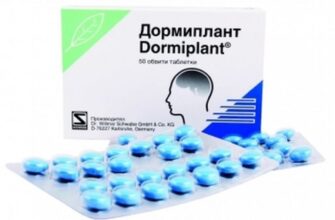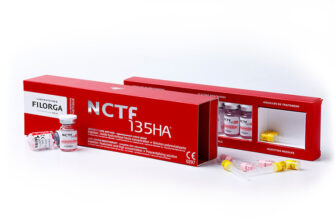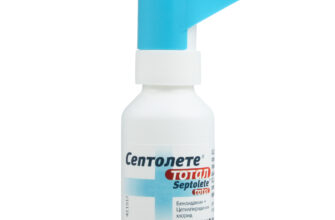Review of the best according to the editorial board. On the selection criteria. This material is subjective and does not constitute advertising and does not serve as a purchase guide. Before buying, you need to consult with a specialist.
You don't need to have a medical degree to understand what seizures are. All of them were with each of us. A cramp is a painful, unpredictable, and involuntary contraction of skeletal muscles. But it happens that the muscle just shakes slightly. So, for example, the eye can twitch spontaneously, or rather the eyelid. This is not a convulsion, but fasciculation, that is, not a synchronous involuntary contraction of the entire muscle, but a twitching of individual fibers that are innervated by a small motor branch. This can be annoying and annoying, but more often than not, it does not apply to the topic of the article.
- What are seizures?
- Epilepsy or Episyndrome?
- The role of EEG in the diagnosis of epilepsy
- From the history of epilepsy treatment
- Review of modern drugs for seizures (antiepileptic drugs, AED)
- First generation probe
- Carbamazepine (Finlepsin, Tegretol)
- Advantages and disadvantages
- Valproic acid (Depakin-chrono, Konvuleks)
- Advantages and disadvantages
- Ethosuximide (Suxilep)
- Advantages and disadvantages
- Phenobarbital
- Advantages and disadvantages
- Second generation seizure medications
- Lamotrigine (Konvulsan, Lamictal, Lamitor, Lamolep, Seizar)
- Advantages and disadvantages
- Topiramate (Topamax, Maxitopyr, Topalepsin)
- Advantages and disadvantages
- Levetiracetam (Keppra, Komviron, Levetinol, Epiterra, Epitropil)
- Advantages and disadvantages
- Neurontin (gabapentin)
- Advantages and disadvantages
- What's next?
What are seizures?
Here is an example of true but localized seizures. Elderly people, as well as patients with heart failure and edema, quite often take diuretics. Furosemide, or Lasix, which has a pronounced diuretic effect, is very well known and effective. But at the same time, it has an important drawback: it also removes potassium from the body along with the liquid. Therefore, if you take it in a large dose, and at the same time do not compensate for the future loss of potassium by (Panangin or Asparkam tablets), you can achieve a state of hypokalemia, in which the concentration of potassium in the blood plasma decreases. A characteristic symptom of hypokalemia after taking diuretics will be cramps, most often at night, and most often in the calf muscles. This is the most common cause of seizures from unauthorized overdose of diuretics.
Physiological cramp can also occur when swimming in cold water, based on the reflex of tonic contraction – an order for intensive work in conditions of vasospasm and a lack of nutrients.
To these examples can be added a number of reasons that are familiar to doctors. It:
- meningitis, or inflammatory disease of the meninges;
- encephalitis, inflammation of the brain substance;
- febrile seizures in children who are safe but very afraid of the parents;
- tonic tetanus cramps, which are so severe that bones are broken.
But in the present, the material will talk about completely different seizures, and about other medicines – not about Panangin, and not about anesthetics, with which opisthotonus (spilled convulsions) is stopped in tetanus. They help with those cramps that are not born in the muscle itself or in a muscle group, but in the cerebral cortex. Simultaneous synchronous discharge of motor or sensory neurons, focal or general 'flash' leads to the emergence of convulsive syndrome in all its variety, or non-convulsive equivalents (sensitive aura, vegetative). This disease is called epilepsy, or epilepsy. But there is also an episode. And what is this, and what is its difference?
Epilepsy or Episyndrome?
In addition to epilepsy, which is considered a primary disease with completely unclear causes, seizure syndrome (epilepsy) can be triggered by other pathologies, such as a brain tumor, or a meninges tumor, which periodically compresses and irritates the cerebral cortex. This condition, in which there is an obvious cause of irritation of the cortex, is called not epilepsy, but an episyndrome. Episyndrome is considered a secondary phenomenon, and it is important to find this cause in time. Quite often, this syndrome occurs as a consequence of severe traumatic brain injury, as a consequence of purulent encephalitis and meningitis, and in other conditions. If, despite all persistent searches for the cause, they have not been crowned with success, and the patient has a periodically obvious clinic of seizures, or their equivalents, then a diagnosis of epilepsy is made.
The role of EEG in the diagnosis of epilepsy
For the diagnosis of epilepsy and epilepsy, there is, in addition to the obvious clinic, only one, but very accurate method of instrumental diagnostics, which is used in different versions. This is an EEG recording, or electroencephalogram, which captures the biocurrents of neurons in the brain. If the encephalogram contains special, pathological rhythms, for example, peak-wave complexes, then the patient has an increased convulsive readiness and epileptic activity. Such a person will not be given permission to drive a car, he cannot serve in the armed forces, he will not be a pilot, since at any moment this convulsive readiness recorded on an encephalogram may manifest itself as a real seizure. There are non-convulsive equivalents that must also be treated.
Anticonvulsants exist for the treatment of epilepsy and seizures caused by focal discharges in various parts of the cerebral cortex. Their other name is antiepileptic drugs, PEP.
You should not think that long-term and sometimes life-long treatment with an established diagnosis of epilepsy with these drugs is only aimed at preventing the onset of convulsive syndrome, although this is also very important. Taking antiepileptic drugs helps prevent the development of characteristic personality changes, which are called epileptoid psychopathy. She is characterized by rancor, excessive pathological thoroughness, scrupulousness, suspiciousness, the ridiculous contrast of the use of diminutive nouns in everyday life ('knife', 'bed'), combined with cruelty.
Epilepsy is a fairly frequently diagnosed disease and is a social problem for developed countries. So, in the USA, about 1% of the population has various diagnoses related to this disease, and more often only a stroke is diagnosed with epilepsy. In total, there are about 50 million patients in the world, and the frequency of occurrence in Russia is on average 7 cases per 2000 population, or 1 case per 285 people. This is quite a lot, and AEDs are in demand. Before considering anticonvulsants and their effect on the body – a little from the history of epilepsy treatment.
From the history of epilepsy treatment
Perhaps the present, scientific epilepsy began in the middle of the 19th century. Before that, the sick were isolated, lived in monasteries, were considered holy fools or diviners of truth. True, sometimes they tried to treat them with craniotomy, which more often ended in death.
The first successful drug that was actually effective was potassium bromide, and bromine compounds began to be used as sedatives and for seizures. The reason for the prescription of bromine preparations was one of the false theories, which believed that epilepsy was caused by excessive sex drive, and the patient should be reassured. With bromine, they just 'guessed', as well as with other means. For about 50 years, epilepsy was treated with bromine preparations, but they do not possess truly anticonvulsant activity, and only inhibit the functions of the central nervous system.
But at the beginning of the 20th century, the first drug with true anticonvulsant activity from the group of barbiturates, called phenobarbital, was discovered. For many decades it has been used to treat various forms of epilepsy, and is still used today, albeit with serious limitations. Surprisingly, phenobarbital is the only non-prescription drug from the group of barbiturates in Russia that can be purchased completely freely, though not in pure form. It is part of the usual Valocordin or Corvalol, together with peppermint oil, hop oil, ethyl bromisovalerianate and ethyl alcohol, providing a sedative and hypnotic effect.
Then discoveries poured in as if from a cornucopia. In the thirties, phenytoin was found, in the late sixties – carbamazepine, which are still considered the 'gold standard' in the treatment of epilepsy. Then, from the eighties and nineties, antiepileptic drugs of the 2nd and 3rd generation began to be used in treatment regimens. This article discusses the most famous tools belonging to the first and second generations – an accessible and popular language.
All drugs for the treatment of epilepsy should prevent the spontaneous development of a general impulse that affects the entire neuron. To do this, it is necessary to reduce the activity of neurons, that is, to reduce the action potential, and the ability of the nerve cell to receive from other neurons and transmit excitation. This is accomplished by various mechanisms. First generation antiepileptic drugs will be considered, and then more modern ones. Synonyms and commercial names registered in the Russian Federation will be given for each medicinal product. For drugs, a range of retail prices will be given that are relevant for pharmacies of all forms of ownership in the Russian Federation for September 2019.
Review of modern drugs for seizures (antiepileptic drugs, AED)
| Nomination | position in the survey | Name of product | price |
| First generation probe | 1 | Carbamazepine (Finlepsin, Tegretol) | RUB 67 |
| 2 | Valproic acid (Depakin-chrono, Konvuleks) | 234 RUB | |
| 3 | Ethosuximide (Suxilep) | RUB 2 190 | |
| 4 | Phenobarbital | 269 r | |
| Second generation seizure medications | 1 | Lamotrigine (Konvulsan, Lamictal, Lamitor, Lamolep, Seizar) | RUB 790 |
| 2 | Topiramate (Topamax, Maxitopyr, Topalepsin) | 736 RUB | |
| 3 | Levetiracetam (Keppra, Komviron, Levetinol, Epiterra, Epitropil) | 776 r | |
| 4 | Neurontin (gabapentin) | 892 RUB |
First generation probe
Surprisingly, all the antiepileptic activity of the first generation drugs was discovered as a result of random studies. There was no purposeful search or modification of already known drugs in search of higher potency. Phenobarbital, phenytoin, valproate, ethosuximide and other drugs were accidentally found. Let's consider those of them that still help patients, even with severe forms of epilepsy, and in some cases they are still preferred by epileptologists even to the newest drugs.
Carbamazepine (Finlepsin, Tegretol)

Carbamazepine is perhaps the most widely used antiepileptic drug. Probably, all other drugs account for less sales than carbamazepine alone.
And this is because its pharmacological action is not only anticonvulsant, but also analgesic. It relieves very well a special kind of pain, neuropathic pain. This pain develops by a mechanism similar to the burst of neuronal activity during an epileptic seizure. This pain occurs after herpetic neuralgia, with trigeminal neuralgia, and is characterized by a very rapid, paroxysmal course, the attack is similar to an electric shock, has an unpleasant, burning shade.
In addition, Carbamazepine is used in psychiatry as a normotimic and anti-manic drug. Carbamazepine acts by blocking sodium channels and thereby inhibits the action potential of neurons. This leads to an increase in the lowered seizure threshold, and reduces the risk of developing a seizure. Carbamazepine is indicated for simple, partial seizures, as well as for generalized conditions, which are called a large tonic-clonic seizure.
If it is used in children, then it is good at reducing depression and anxiety, reduces the potential for irritability and aggression. Also, Carbamazepine is prescribed in the treatment of chronic alcoholism, for the relief of alcohol withdrawal syndrome, symptoms such as hyperexcitability and tremors.
There is also carbamazepine in a prolonged form, which acts for a longer time, for example, Finlepsin Retard. The merit of this form is that the concentration of the substance in the blood plasma is more constant and stable, and less prone to jumps. This improves the anticonvulsant effect. The introduction of the prolonged form has led to the possibility of using Carbamazepine only once a day.
Carbamazepine is listed annually on the Essential Medicines List (EML) and is inexpensive. So, Finlepsin in a dosage of 200 mg No. 50 costs from 200 to 270 rubles, and the domestic INN-generic Carbamazepine produced by 'Obolenskoye' can be purchased even for 60 rubles. Of course, there is a suspicion that it will not perform as well as well-known brands.
Advantages and disadvantages
The advantage of carbamazepine can be considered the breadth of action, it is used in various forms of epilepsy, and not only in it. It is cheap, can be prescribed without any problems for a long period, but has some limitations. It cannot be used for severe anemia and a decrease in leukocytes in the blood, with cardiac arrhythmias (atrioventricular blockade), in case of hypersensitivity to tricyclic antidepressants, of which he is a representative.
Care must be taken in heart failure, and especially in combination with chronic alcoholism, in the case of increased secretion of antidiuretic hormone and adrenal insufficiency, as well as in glaucoma. It is especially necessary to carefully monitor pregnant women, who should use Carbamazepine in minimal dosages. Also, the disadvantage is the need to take the drug quite often (except for the retarded form), up to three times a day. Against the background of carbamazepine, various side effects develop, most often drowsiness, dizziness, loss of appetite and other disorders. Therefore, after starting treatment, the patient must be observed by a doctor. There are also overdose symptoms and special interactions with other medications, but they are all known and well studied.
Valproic acid (Depakin-chrono, Konvuleks)

This first generation drug is widely known in our country under the name Depakin-chrono, which is produced by Sanofi, or Konvuleks, of the Austrian company Valeant. This medicine is two or even three times more expensive than Carbamazepine. Depakine 500 mg No. 30 costs from 220 to 650 rubles, and Konvulex has about the same cost.
The active substance of Konvuleks is valproic acid, therefore experts call these drugs valproate – soluble salts of this acid. They are used in hospitals and outpatients, available in tablets, syrup, and even ampoules for intravenous use.
The drug, in addition to the anticonvulsant effect, relaxes the muscles, acting as a central muscle relaxant (Mydocalm, Sirdalud), and produces a sedative effect. It increases the concentration of an inhibitory mediator, gamma-aminobutyric acid, because it blocks the work of an enzyme that destroys this mediator.
Valproic acid is indicated for severe enough disorders, such as status epilepticus, when it is administered intravenously. Also, medicines are used for large, or generalized seizures in adults and children, which can proceed differently. Konvulex is also treated with specific syndromes that cause severe epilepsy in children, for example Lennox-Gastaut or West syndrome. The drug is used to treat febrile childhood seizures, as well as to treat manic-depressive psychosis in psychiatry, which is now called bipolar disorder. The drug should be used in those dosages and according to the scheme prescribed by the doctor, any self-medication is excluded.
Advantages and disadvantages
The drug is available in various dosage forms and can be used in pediatrics, psychiatric practice, and in the relief of emergency conditions. Plus valproate is also that the remedy is effective for all forms of seizures and for all types of epilepsy, so it can be used to start treatment of any form of epilepsy, and valproic acid will be the drug of choice, or the first line.
The drug is available, it still has a not very high price, but it has a number of contraindications. First of all, these are severe violations of the liver and pancreas, hepatitis and pancreatitis, a decrease in platelets in the blood plasma, as well as pregnancy and breastfeeding. With great care, valproates are prescribed for children, and especially under the age of three years, as well as if the child is taking several antiepileptic drugs at once. The combination of drugs is always less predictable than monotherapy.
The advantage of Konvulex and Depakine can be considered a fairly good tolerance, and a low number of side effects that depend on the dose. If there are side reactions, then it is most often nausea, a feeling of fatigue, flashing of flies in front of the eyes, anemia or changes in body weight, both upward and downward. In the analyzes, the patient may have an increase in the level of bilirubin, the concentration of hepatic transaminases and nitrogen.
Do not combine the simultaneous administration of valproate and carbamazepine in one patient, since Konvulex, together with carbamazepine, contributes to an easier overdose of the latter. Do not combine Konvulex with phenobarbital, neuroleptics, antidepressants and some antibiotics from the carbapenem group.
It is strictly forbidden to take alcohol against the background of treatment with valproate, as, indeed, in the case of other drugs, because taking ethyl alcohol facilitates the appearance of epileptic seizures. The combination of ethanol and valproate intake leads to its increased toxic effect on the liver.
Ethosuximide (Suxilep)

This first generation antiepileptic drug can be considered by far the most expensive. A bottle of capsules, however, in the amount of 100 pieces, will cost about 3,000 rubles, it is rarely found in pharmacies, and may even be in short supply. If we talk about the average, optimal daily dose, then this is 15 mg per kg of body weight in adults. Therefore, a person who will weigh 80 kg will need 5 such pills per day, which means that the package for 3000 rubles will end after 20 days of taking. The cost of a monthly course will be approximately 4500 rubles.
Why is Suksilep used? First of all, for the treatment of minor epileptic seizures. Its niche is special minor seizures with a myoclonic component, impulsive juvenile minor seizures, and special forms of absences. This 'narrow specialization' allowed Suksilep to be a leader in a 'narrow niche', which is in demand despite its relatively high cost. As in any other case, the antiepileptic drug Suksilep begins to be used with titration of the dose, gradually increasing it by one tablet every 5 days until the seizures decrease or disappear completely. You can increase the drug, but only to the limit – up to a dosage of no more than 6 tablets per day.
Advantages and disadvantages
Suksilep is usually well tolerated, and from contraindications – these are pronounced dysfunctions of internal organs: liver and kidneys. The drug is contraindicated in pregnant and lactating women, and the side effects of this drug are about the same as those of carbamazepine. Naturally, the biggest disadvantage of the drug is its high price and it is not always available in pharmacies. But still, given its unique effect on special forms of epilepsy, one has to put up with these shortcomings – after all, there are no competitors yet. The drug is produced only imported: by the French company Delpharm Lille, or by the German companies – Jena Pharm, and Mibe Artsneimittel.
Phenobarbital

Phenobarbital is a really cheap drug and should be the starting point for a seizure medication review. One pack of 10 tablets, 100 mg each, is sold for only 23 rubles. The federal enterprise, the Moscow Endocrine Plant, has practically a monopoly on the production of phenobarbital. In addition to this dosage, it is available in 50 mg tablets and 5 mg tablets.
The official instruction for phenobarbital states that it is not only an antiepileptic, but also a hypnotic drug. Like all barbiturates, it interacts with a special structure of gamma-aminobutyric acid, and reduces the excitability of the cell membranes of neurons. Phenobarbital at high dosage causes drowsiness, hypnotic effect and sedation. That is why he is part of Corvalol.
Phenobarbital has another important property that is not classified as epilepsy. It treats jaundice, but only that jaundice that is associated with hemolytic disease of the newborn, and is not a consequence of viral and alcoholic hepatitis, liver cirrhosis. In addition to epilepsy and convulsive syndrome in newborns, the drug is indicated for spastic paralysis, agitation, sleep disorders, if special, expensive modern drugs are not available.
It is for this, for 'plugging holes', that Corvalol is produced. If we count the amount of Corvalol that is sold annually in Russia, then phenobarbital, even purely by weight, will be the most commonly used anticonvulsant drug used for other indications. Phenobarbital should be taken with caution, and only on the advice of a specialist! Few people know about this, but only 2 g of phenobarbital taken by mouth can be fatal, and ingestion of 1 g causes serious poisoning. This means that half a glass of Corvalol, or 100 ml, drunk, for example, for the purpose of alcoholic intoxication, contains 1.82 g of phenobarbital, and after such a 'dose' you may not wake up.
Advantages and disadvantages
About phenobarbital, or you can put it in a proverb: 'an old horse will not spoil the furrow.' This remedy for many years, and even decades, was an effective anticonvulsant drug, but its long-term use, it turned out, causes significant disorders of mental functions, leading to a decrease in intelligence, memory depression. Patients who were on phenobarbital monotherapy for a long time developed quite serious psychoses, especially in childhood.
At the same time, the range of action of phenobarbital on various forms of epilepsy is not as wide as that of carbamazepine or valproic acid.For example, if we are talking about absence epilepsy, then on the contrary, it aggravates the course of this form of the disease, and even sometimes provokes seizures. Therefore, at present, phenobarbital, despite its widespread and cheapness, is considered the best first choice drug only when it comes to convulsive seizures in newborns.
Second generation seizure medications
Since the early 1990s, second-generation seizure medications have been included in clinical practice. These are such drugs that have now become famous as Neurontin and Lamictal, Keppra and Trileptal, Lyrica and Topamax. other means.
If we compare them with the first generation drugs, then their main difference is a targeted search, not an accidental discovery, and a much smaller number of side effects. First-generation drugs quite often influenced various enzyme systems and inhibited or increased their activity. This caused unwanted surges in hormonal levels, provoked cognitive disorders. Therefore, in the treatment of epilepsy with second-generation drugs, there is more simplicity in the schemes, and patient adherence to treatment is much higher. Of course, the cost of these drugs is higher.
Given that personality changes are possible in patients with, for example, generalized epilepsy, such compliance, or adherence, is absolutely essential for success. In general, their main difference is greater security and better portability. In order not to list or repeat, here are the most common common side effects for gabapentin, topamax, and lamotrigine. Most often, of course, there was dizziness, and then – transient diplopia, or double vision. Speech disorders appeared on Topamax, but drowsiness was always the most frequent. Consider the most typical and popular second generation remedy for seizures.
Lamotrigine (Konvulsan, Lamictal, Lamitor, Lamolep, Seizar)
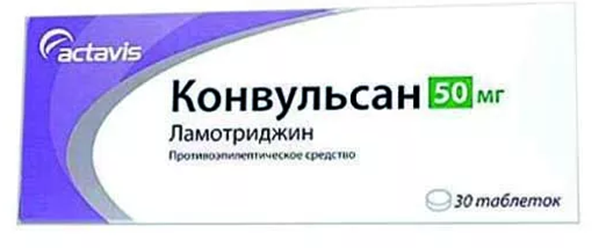
Perhaps Lamotrigine is the best-known second-generation drug among epileptologists, and it is a folic acid antagonist and a fairly good sodium channel blocker. Its role is to suppress the release of neurotransmitters that excite neurons into the synaptic cleft. It is quickly absorbed when taken orally, and lives in the body for a long time, its half-life is more than 30 hours. Therefore, Lamotrigine can be taken in the morning, once a day.
Lamotrigine is indicated for admission in persons over 12 years of age for the treatment of various forms of epilepsy, the listing of which does not give anything to a person without medical education. For example, this is a combination therapy of refractory partial epilepsies, as well as Lennox-Gastaut syndrome in children. But it can also be used to treat large seizures, that is, generalized epilepsy. Importantly, the International Antiepileptic League named it the drug of choice for the elderly with a high level of evidence for the treatment of partial forms.
The average daily dose of lamotrigine, for example, in combination with carbamazepine, is 400 mg. It is also used to treat parkinsonism and reduce the risk of depression in bipolar disorder.
The original drug Lamictal, produced by the UK-based company Glaxosmithkline, will cost an average of 2,000 rubles. per pack (capsules 100 mg # 30), and this pack may last for a week. Accordingly, a monthly course of treatment with the original drug will cost 8,000 rubles. per month. This is very, very expensive for a Russian. The drug Lamolep of the Gedeon Richter company will cost 1400 rubles. in the same dosage, and a monthly course will cost 5500, but this is also a high cost. The cheapest analogue is Lamotrigine, an INN generic from Canonpharma, and its cost is about 600 rubles. per packing.
Advantages and disadvantages
Of the side effects of Lamotrigine, the most common, and, alas, unpleasant and dangerous, are skin rashes, or exanthema. Quite rarely, it manifests itself as a severe syndrome – Stevens-Johnson or Lyell, when the skin exfoliates, and this condition is life-threatening, and is characterized by high mortality. If only the patient, while taking Lamotrigine, has the slightest hint of a change in the skin, then the drug is urgently canceled, since in most cases the rash is persistent and irreversible. This is of course a very serious side effect, but fortunately very rare. This development can be avoided if the dose is increased very slowly when the desired concentration is selected.
Other 'side effects' include vitiligo, drowsiness and nausea, decreased plasma platelets, leukopenia and increased liver transaminases. But if we talk about side effects in the population, then Lamotrigine is well tolerated. In patients, in addition to the antiepileptic effect, mood improves, it exhibits an antidepressant effect and improves attention. Including Lamotrigine, it is good for treating epilepsy in the elderly, and especially in the presence of depression.
Topiramate (Topamax, Maxitopyr, Topalepsin)
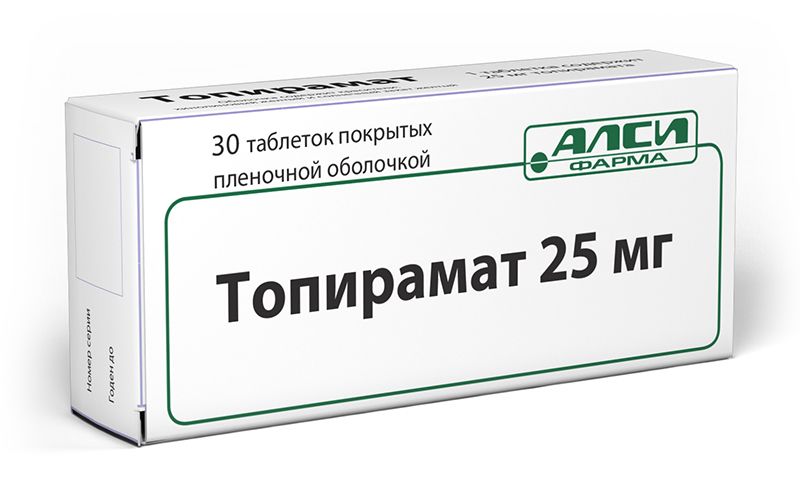
The original Topamax, which is produced by Janssen Сilag from Switzerland, costs from 1100 to 1300 rubles per package (60 capsules of 50 mg each). The domestic analogue can be bought at a price of about 190 rubles, but it must be borne in mind that the concentration is half as much, 25 mg, and the number of capsules is also half as much (30 pcs.). Therefore, it is necessary to immediately multiply by four in order for the comparison to be honest. And then the equivalent amount of topiramate produced in Russia will cost about 800 rubles. Therefore, it is better to hold out a little and buy the original Swiss drug.
Topamax reduces the frequency of the action potential, and works with gamma-aminobutyric acid to block sodium channels. He is indicated for treatment strictly older than two years of age, both for newly diagnosed epilepsy, and as part of a complex treatment, along with other drugs. It is important that Topamax can be used to prevent migraine attacks, and is used only in the interictal period.
You need to use Topamax by opening the capsules and mixing them with any soft food, swallow immediately and without chewing. You can swallow it whole, but preliminary dispersion of the product causes faster and more uniform absorption. The average daily dose, which should be carefully selected with your doctor, is approximately 300 mg. This means that the original remedy will last for 10 days, and the cost of a monthly course of treatment will be approximately 3300 rubles.
Advantages and disadvantages
Topiramate is well tolerated, there are no withdrawal symptoms if it is necessary to abruptly cancel this remedy. Most often, patients experienced a decrease in body weight, which is dose dependent. In the presence of obesity, this is a very positive, but, alas, not an obligatory side effect. However, there was something else. The concentration of attention decreased, dizziness, drowsiness, and weakness appeared. This means that during treatment with Topamax it is better not to drive. Of course, this applies to persons with migraines, since driving is prohibited for patients with epilepsy. In addition, topiramate is contraindicated in pregnant and lactating women, and in patients with urolithiasis, since the agent can lead to the formation of calcium or phosphate stones – it alkalizes the urine. Especially should be observed women taking hormonal contraceptives while taking Topamax. The effectiveness of contraceptives can be significantly reduced.
Levetiracetam (Keppra, Komviron, Levetinol, Epiterra, Epitropil)
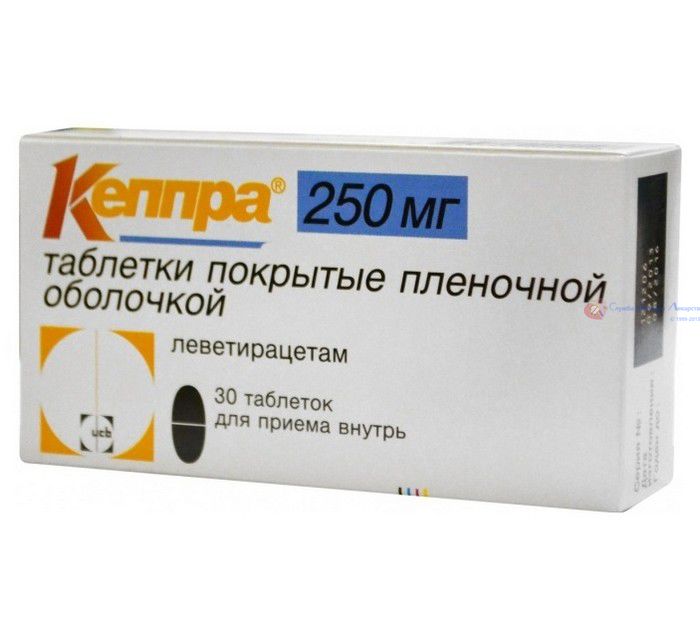
For the first time, the Croatian company Pliva began to produce Keppru. Now it is produced by the Belgian company UCB – Pharma, and in Russia the agent is produced in the form of levetiracetam by the companies 'Ozone' and 'R-Pharm'. One package of Keppra tablets in the amount of 30 pieces will cost about 800 rubles, 250 mg each. The domestic medicine will cost more than half the price, levetiracetam of the Ozone company in September 2019 can be bought for 315 rubles.
This drug remains largely a mystery, since the antiepileptic mechanism of levetiracetam is still unclear. However, it is used both for partial seizures and for primary generalized, large seizures in adults and in children over 12 years of age. Partial seizures may or may not have secondary generalization, but levetiracetam will be quite effective. It is applied twice a day, and the dose begins, one tablet twice a day. This is the stage of getting used to the drug and assessing its tolerance. After 2 weeks, the dose is doubled to 1 g per day. Usually, at this dosage, the therapeutic effect begins, and if necessary, it can be increased, but not more than twice, up to 3 g per day. In addition to such monotherapy, there may be complex therapy, when, in addition to levetiracetam, any other drug is prescribed, then the calculation is made based on the dosage per kilogram of body weight.
Advantages and disadvantages
Keppra and quality levetiracetam are well tolerated and significantly improve the quality of life of patients. Of the side effects, drowsiness is most often, and the higher, the more pronounced it is. In second place – weight loss, diarrhea, double vision. Of course, it is undesirable for persons with the development of drowsiness to drive, but a patient with a diagnosis of epilepsy cannot get the right, so this condition is not very relevant. Also, patients with such a diagnosis are prohibited from working in hazardous working conditions, with moving machines and mechanisms, this must also be taken into account. After all, not always a patient with a newly diagnosed convulsive syndrome can be immediately removed by the labor protection department, or transferred to non-hazardous work. Do not use levetiracetam in tablets for children under four years old, and in solution – up to 1 month. Caution it is prescribed to the elderly, and to persons with severe liver damage. In extreme cases, the medicine can be used in pregnant women and during breastfeeding, but this must be decided by the council.
Neurontin (gabapentin)
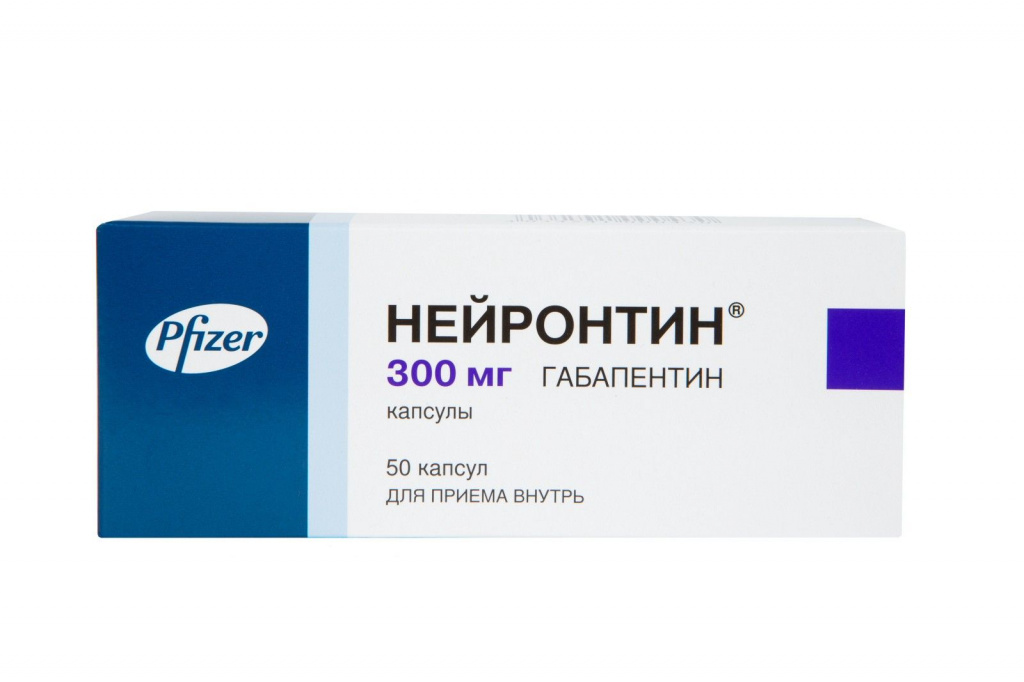
Unlike 2nd generation antiepileptic drugs, gabapentin gained triumphant fame in addition to the treatment of epilepsy, and in another area it is the treatment of neuropathic pain, and is more effective than the appointment of carbamazepine. It is known to significantly improve the quality of life for chronic, burning, and uncontrolled pain by carbamazepine. Gabapentin works for conditions such as trigeminal neuralgia, a condition after herpes zoster called postherpetic neuralgia.
The most expensive drug is the original drug Neurontin from Pfizer. One package of 300 mg capsules in the amount of 50 pieces will cost an average of 1,000 rubles. The drug Tebantin from Gedeon Richter will cost about the same. The maximum cost of Konvalis (domestic company Pharmstandard – 700 rubles), and Catena from Belupo costs from 350 to 680 rubles.
It would seem that this is a low cost, but, unlike other drugs, the selection of gabapentin therapy and increasing the dose can have rather large limits.
Gabapentin works a little differently than a simple sodium channel blocker. It does not at all affect the uptake or metabolism of GABA, this inhibitory mediator. It is believed that it affects in general, not the sodium channel, but the calcium channel. It is important that it does not affect the metabolism of dopamine, serotonin and norepinephrine, and does not have the side effects of SSRIs, which are used as widely used antidepressants.
The drug is indicated, first of all, for the treatment of neuropathic pain, and as an anticonvulsant agent – for the treatment of partial seizures with and without secondary generalization in children over 12 years of age and in adults. It is also used as an additional drug in complex therapy for the treatment of partial seizures.
It was said above that Neurontin and its analogues are sold in 300 mg capsules, and you need to start one capsule 3 times a day. The maximum dosage is 4 times more, that is, 3600 mg per day. But doctors note that a dosage of more than 1800 mg per day is unlikely to give a positive effect, usually pain relief or anticonvulsant activity works up to this dose, that is, up to a dosage of 2 capsules 3 times a day.
You should not be afraid that the drug will be poorly tolerated, it is well tolerated in doses up to almost 5 g per day. It is estimated that one package of Neurontin will last for about 3 days with an average dose calculation. Then the monthly course will cost 10,000 rubles. Given its long-term use in the treatment of neuropathic pain, this pharmacoeconomic aspect is a known problem.
Advantages and disadvantages
The great advantage of gabapentin is its really proven efficacy, reducing the burning and unpleasant pains that torment people at night, and even causing suicide. An inconvenience can be considered a frequent intake – three times a day, the need to count the number of capsules until the desired effect is achieved. On the other hand, gabapentin is very well tolerated by almost everyone, and the most common side effects are constipation, shortness of breath, blurred vision. Effects are dose dependent, and drowsiness and motor coordination disorders may also occur at high dosages.
It should be remembered that it should not be used in children under 12 years of age as the main drug for the treatment of partial seizures. During pregnancy and lactation, it can be used, but again – by agreement of specialists, if the benefits to the mother outweigh the potential risk to the fetus. Since this drug is secreted into breast milk, and the effect or lack of it on the infant is unclear, breastfeeding while on gabapentin treatment is necessary given this risk.
What's next?
Today, the 21st century has changed its second decade. Pharmaceuticals of the 3rd generation are already ready, for example Briviak. However, their purpose is still inferior to the drugs of the first and second generation, since even their potential is not yet clear to the end, and even the second generation drugs can be safely used for several decades for the treatment of epilepsy.
On the other hand, co-administration regimens are constantly improving, new possibilities are opening up, self and drug combinations. Some experts believe that existing drugs are sufficient. Adherence to the following principles of treatment will give a much greater effect:
- start treating epilepsy as early as possible, which means that it is necessary to diagnose it in a timely manner as accurately as possible;
- you need to choose a medicine as a monopreparation. This, that is, treatment with one drug, is much more desirable than a combination of two or even three antiepileptic drugs;
- rationally control the dose, and reduce it to an acceptable level when the effects will exceed minor side effects.
In addition, non-medicinal methods of treating this ancient, but so well-known disease are constantly being improved. Therefore, in the event that you or your relatives have incomprehensible seizures, then you need to urgently contact a neurologist. It is very important to remember that epilepsy is not always a seizure. They can be regarded as falling, incomprehensible fainting, seizures similar to hysterical, as well as simply an incomprehensible state of stunnedness, and freezing in one position. Sometimes outpatients arise automatically. It's good if this is not a key press on the computer. But sometimes you can continue to cut your own fingers instead of onions. Only after conducting electroencephalography with provocation, and possibly several times, after a thorough examination by a neurologist – epileptologist, can a diagnosis be made and treatment prescribed.
Attention! This rating is subjective and does not constitute an advertisement and does not serve as a purchase guide. Before buying, you need to consult with a specialist.



